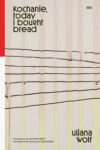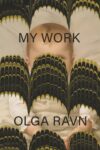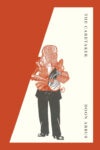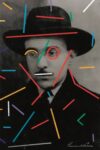
This piece is a contribution to a two-part forum on Personhood. You can read the first part here.
[New Directions Publishing; 2021]
Human history is a history of stories. Today, the importance and primacy of stories seems uncontestable. In the move from simple, universal fact, to story, is the awareness and acceptance of a complex and multitudinous truth. The belief in story as an approach is today evidenced both in the debates over removal of its memorabilia and in the rallying cry that we “believe her.” Arguably, one of the most pressing questions is not about the primacy of story or storytelling itself, but rather, who gets to tell stories and which ones are believed. In her essay collection, Personhood, Thalia Field wonders at the story’s limitations — what it can’t say, and who and what is left out of its logic. In Personhood’s case,this has to do with the wild: cockatoos and elephants, rivers and trees, “invasive” rabbits and feral pigs. For Field, language has the capacity to domesticate and to hold captive just as much as cages do. The threat of extinction, of suffering, and of captivity, both amid and distinct from the increasingly dire consequences of climate change, per Field, are in collusion with the stories we tell of the wild — the symbols, metaphors, legal jargon and scientific proceedings.
So, how does one talk about the wild?
And, how does one fight for it?
Personhood is Field’s experiment in answering these questions. The prose is taut, cunning, and funny. It pieces together historic, religious, juridical and childish tales, stories, legacies and myths — of intelligence, Noah’s Ark, the maypole, and Goldilocks — to not only make evident the absurd extent to which human beings have attempted to understand, to contain, wildlife, but to also exhaust the possibility of story itself. Leading by example, Personhood’s uncontainedness makes it difficult to extract from — to tell a story about. There are no neat parts and, reading the book, one senses the tides of its continual raveling and unraveling, symbiotic extension and erosion.
Thalia Field’s interest in animals and the stories we tell of them spans, now, three books. Her previously published Bird Lovers, Backyard and Experimental Animals: A Reality Fiction form her trilogy with newly published, Personhood, as each, in experimental and genre-bending essays, dissect the stories and histories we tell of animals. In Personhood, Field’s focus is primarily the non-domesticated. The ten essays respond to an early twentieth–century debate over nature writing popularly referred to as the “Nature Fakers Controversy” which pitted the lyrical and sentimental against the scientific, the naturalist against the literary. Both were in a contest to see who knew animals better. Theodore Roosevelt got involved. Yet, for Field, neither gets it right. Her trouble with both is the presumption of finality and fixity, that there is an end to knowing and that all is knowable if only to be uncovered through its means. The trouble, further, is the naturalization of its assumptions. Even science, Field would contend, tells a specific story from a specific, and humancentric, point of view.
Field’s essays, in relief, neither center the human nor any one of its stories. Her prose is a refusal in inhabiting any one voice, human, animal, or otherwise. The reader comes not to an ending or resolution, but displacement and dispersion — questions not answers. Between her first essay of the collection, “Hi Adam!” — on domesticated and abandoned cockatoos — to her final essay-poem, “Glancing Backwards,” — on the death of animals at the hands of those who say they love them — Field resists easy explanations.
On the grounds of this resistance is the belief that one’s ethical relationship to the other is contingent on the language we use to understand it. Personhood’s publication is coincident with an accelerating concern for animals — domesticated, and not. Awareness of, and protest against, the treatment of factory farmed animals is rising as non-animal meat and non-dairy milk dig into the market share. “Bunny the sheepadoodle” is famous on TikTok for pawing at a soundboard and ‘saying’ things like, “Shut up and walk me.” The 2020 film, My Octopus Teacher, won an academy award. Every day in my inbox I receive petitions about dog fighting and poached rhinos. My concern here, and what makes Field’s project distinct, is the reframing of the ethical relationship between humans and animals. While important steps are being taken for the plight of animal rights, Field ultimately suggests that until animals can be freed from the figurative and imaginative captivity built on the stories we tell of them, our ethical and ontological relationship to them remains fraught — Bunny can only talk if she can speak our language; the octopus is only valuable if we predicate its value on our capacity to bond with it.
In an attempt to uncenter the human — and any center, for that matter — Field replaces hierarchy with an ecology. Personhood is an experiment in continually approaching its object, of making multiple and simultaneous advances, without inhabiting it, pinning it down, or summing it up. Personhood’s essays are not directed or connected by a singular voice, but are rather sites for the cacophonous orchestration of often conflicting voices. Her interdisciplinary sourcing creates a collage of so many of the stories we tell of the wild — of Adam and Eve, of intelligence, of Mama Bear, Papa Bear and Baby Bear, of invasive species, of the Liberty Pole, of the beast within us — that the idea of truth being held within any one becomes inconceivable. There is no center. Instead, meaning is had in the in-between, in the liminal space between the figurative and the literal, the human and the wild, as Field playfully maneuvers between and obfuscates the two. Field lays bare and sacrifices the false precision of definitions — legal or otherwise — for another kind of precision, without at the same time positing that precision doesn’t exist at all. Field’s resistance to what she’s called “conceptual solidity,” and her precision all the same, requires of Personhood that its thinking be perpetually enacted on the page rather than simply before it; that its thinking exists only in enactment and cannot be preemptively set down.
In many essays, Field dramatizes and makes visible this enactment. Meaning is performed and exists only in the web of voices packing its stage. It is in the dramatization of this stage, in the explicitness of performance, that Field reinforces her idea that humans are both participants and often unknowing actors in the reality which the stories we inherit and create manifest. In “True Crime/Nature Fakers,” Field employs [bracketed prompts]. She writes, for example, “Who dared transpose [1 human activity] into [3 qualities of your favorite woodland creature] without morals, without ethics, without admitting how the stories were [definition: “unrealistic”] or chock full o’ [2 kinds of analogy].” By substituting the assumptions stories make with prompts, Field denaturalizes them, unlinking referent and reference, and stripping it of its lubricating emotion. Meaning is indeterminate and unfixed as Field makes the explicit story’s dependency on the reader’s timely improvisation. The visibility of the stage is simultaneous to the visibility of the fact inherent to the stage: that things that don’t cohere with the reality it fabricates will be left out of it.
Whether through the explicit employment of the stage and the voices arising from the depth of its curtain or not, Field’s intention is to watch “thoughts and questions pass through writing” rather than to be transformed by them. In Personhood, voices are often speaking past and around each other, rather than directly to. The court written about in Happy, the elephant’s story — the second story in Field’s collection — responds to the lawyer questioning the validity that “only humans can be person,”: “I’ve always enjoyed elephants.” In others essays, there are often more lists than verbs: “Diagrams of science-y things: Broken bedrock. Shale deposits. Land and see empires of petro-chemical companies” or “the premises: coffins pulled up hills by horses, boat masts, lathed; furniture to be defended”. Everything simply appears without explanation or origination in action. In both cases, Field satirizes the non-sequitur and renders visible the disjuncture, or senselessness, in current animal and environmental discourse and earthly conditions.
Really, the disjuncture is threefold: linguistic, figurative, and ecological. The domination and consequences of these linguistic, figurative and ecological impositions means that wild animals are not only trapped but don’t have the tools to get themselves out. Today, the WWF reports that the world population of wild animals has fallen by an average of 68% since 1970. The climate crisis means that animals across the world inhabit an environment that no longer makes sense to them or the millennium of years that informed their evolution. Forced captivity of non-domesticated animals likewise places animals in a logic that has no way of cohering with their own.
The abandoned cockatoos of Field’s first essay, “Hi Adam!” most pointedly highlight this disjuncture, and the simultaneity of a linguistic and material captivity. In the essay, Field writes of the purgatory these birds now face in their Rhode Island Sanctuary as their owners, for whichever reason, have left them. She pays special attention to one particular bird named Adam. Bidding for attention, Adam constantly calls out into the warehouse-sized concrete-laden sanctuary: “Hi Adam.” It’s as if they are the only words she knows. She echoes her former owner, and evidences the void of his absence, replaying his words and reversing their address. Field writes, “only obedience gives meaning to a command — as a name does for he who names.” In the absence of her owner, Adam knows nothing else but to play both parts — the one who names and the named — stuck in a loop of logic that no longer exists. Living up to one hundred years, the cockatoo, like most parrots, bonds for life. So, when she is stolen or trafficked from the wild, her owner will replace her cockatoo counterpart and become the only object of her love — first as a parent, and then with age, as a lover. Enduring abandonment, many cockatoos will suffer out of grief, and will die of self-mutilation. Adam does not understand the logic of her owner’s moving on, and is cursed by her now ungratified dependency. Like the migratory birds who return north to find their homes ruined by climate change or deforestation, the cockatoo now has “nowhere to perch but on Noah’s outstretched finger.” When Noah gets a new job, decides to move, no longer wants to clean a dirty cage, and abandons the cockatoo, Adam has no way of understanding. At the intersection of two worlds, “Hi Adam” loses its referent. The language repeated back is only an outline, a simulacrum, yet is stuck forever in Adam’s head. Even in her imitation, Adam transgresses, loves too much, her desperation having no other language than the one she has rid of sense. “No matter how many phrases they learn,” Field writes, “no wild animal, under any circumstance, can find a home in a human place.”
Legally, the defense of animals and environments and the fight for their personhood is likewise caught between incoherent worlds. In the case of Happy the elephant, who’s been held captive in the Bronx Zoo in a solitary pen for forty years (despite the fact that the zoo has closed its elephant program) after being abducted from her herd in Thailand, the fight for her freedom is based on something referred to as the mirror self-recognition test. The mirror test is an invention created to determine self-awareness, intelligence and ultimately, which beings merit freedom. In the test, the animal is marked by a pen or sticker on an area of their body and then given a mirror. If the animal notices and then touches, cleans, or investigates this mark, it is said they’ve passed. Yet, as Field notes, the mirror test is not a determination of how one sees oneself; the mirror is “to see oneself as others do,” and therefore as “a reflection of a world that would claim to name you.” The mirror is still an othering — an alienating device. Even anti-cruelty laws, Field notes, defend the interests of an amorphous ‘justice’ rather than the animals themselves. A law professor that Field quotes rebukes the possibility of the legal endowment of personhood onto animals because “legal persons can’t be eaten,” even though human beings are the ones deciding to eat them. Animals are placed in an impossible position: in a trap of a contradiction and the incoherence of an impossible effort to explain away.
Even amongst destruction, extinction, and suffering, humans can’t help but make stories of the wild. The sentimentality of these stories contradicts the logic we impose at the prospect of the death of any non-human animal. One (let’s say I) is not supposed to grieve over the dead rat in her kitchen and spend hours combing over scientific papers on the rituals of rat mourning because it’s just one rat. Of course, my own grief towards the death of this rat at the hands of a trap I knowingly allowed does no one any good, including the rat. But how does one manage the dissonance between Stuart Little and mass extermination? Or the difference between ‘it’s just one rat’ and ‘it’s just one human’? In grieving the death of the rat as one would one’s neighbor, one runs the risk of anthropomorphization. At the same time, that which is deemed the appropriate level of grief in each case (one doesn’t attend the rat’s funeral, say) is wholly humancentric. Likewise, the Liberty trees of Field’s sixth essay are revered as historic symbols of freedom, justice and American patriotism, while their counterparts are logged mercilessly in the plight of deforestation. One can simultaneously confess their love for animals, exclaim at their cuteness, invent Peter Rabbit, Roger Rabbit, the Velveteen Rabbit and the Energizer Bunny, and yet remain bystanders to the deliberate mass extermination of feral rabbits by the implantation of a virus specifically designed to kill them.
The solution is not that one simply writes a better story, but rather that one entirely rejects the story itself. Story’s capacity to “put others in their places,” to naturalize and impose upon the other a single reality out of infinite is, for Field, its “subtle violence.” It is, For Field, story’s finality — its inherent demand that it end, that there are no loose ends — means that it must, in order to “make this lovely shape,” impose an order where everything means exactly, explicitly and “naturally” one thing and that all these things add up to a whole number. Story denies the possibility of not knowing; it has no room, writes Field, for the “slips” of a “fetid leftover.” Story cannot preserve what, in reference to another object that refuses neat and knowable ends—the Black archive of the enslaved — Stephen Best calls “illicit utterance” and “impossible speech”: that which “eludes the tenets of empiricism and documentation.” If one cannot comprehensively know the wild — its intelligence and systems eluding the easy explanations and categories of our own — is there still a way for us to take action for it?
To what extent, say, do the petitions filling my inbox serve the wild animals they rally for? Personhood, as Field herself points out in a recent interview, will not reach as many eyes. The language used in the emailed pleas for signatures are a means toward an end. In Personhood, the end is perpetually delayed, refused. The question at hand is both about the way activism (often online) is founded on the emotion captivated and created by stories and whether one’s responsibility toward the other is contingent on understanding it, and moreover, on feeling for it. For Field, it seems possible that the stories we tell of animals in order to elicit support for them can also be the same ones that reinforce a logic founded on their ontological captivity. This is, of course, to say nothing of the way an emotional narrative can often lead us to aid or donate for a cause that is significantly less effective than another, less heart-wrenching one. It is our employment of language, according to Field, that not only describes our relationships to animals, but shapes it.
In an interview with the Seneca Review well before Personhood’s publication, Field admits: “There is a comfort in questioning without needing answers.” In Personhood, Field extends her line of questioning: the wild’s refusal to be deduced, its unruliness, means that the way one comes to approach it is not through knowing, but overhearing and glimpsing, that is to say, without ordering it in a system of meaning, without making it mean. While refusing direct apprehension of its subject, Personhood is no less steeped in urgency. In the same interview Field says, “Thinking will not help anyone when its relationship to ethics is severed.” In Personhood Field does not deny that knowledge exists at all. Rather, she uses her work to question what we do with it, what we turn it into, and how we got it in the first place. Progress is a perpetual question.
Samara Michaelson writes and reads in New York. She is a graduate of the University of California, Berkeley and the University of Cambridge. Her interests revolve around aesthetics and the philosophy of literature.
This post may contain affiliate links.







